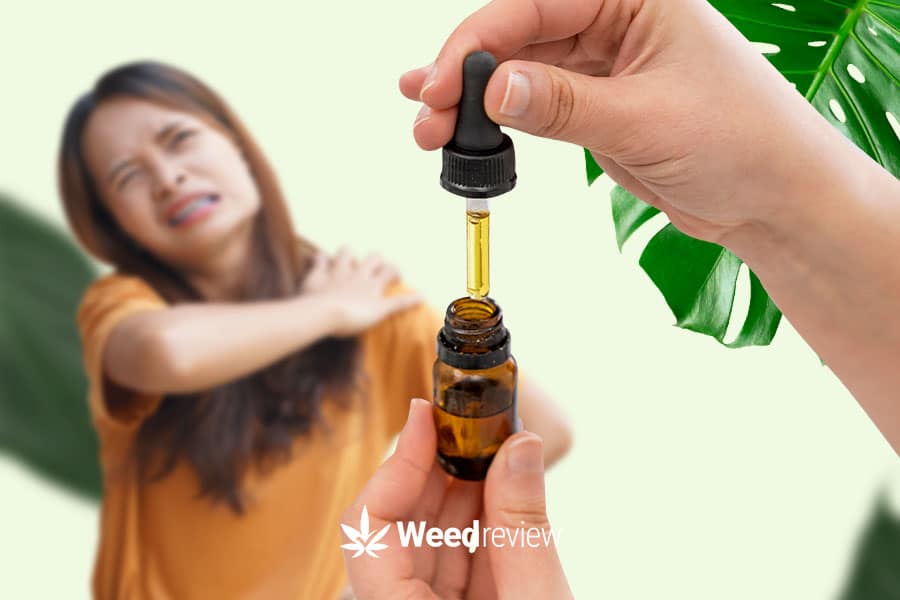
How to Use CBD for Pain Relief

Table of Contents
In an era where natural remedies are gaining popularity, CBD (Cannabidiol) has emerged as a promising tool for pain management. Due to its potential therapeutic properties, CBD is increasingly being added to various products to relieve symptoms associated with chronic pain, inflammation, and other conditions.
In this article, we will explore how to effectively use CBD for pain relief, focusing on the most popular forms of consumption – flowers, topicals, tinctures, and edibles.
A quick intro to CBD
Cannabidiol, or CBD, is one of the many cannabinoids found in Cannabis plants, particularly hemp. Unlike its counterpart THC (tetrahydrocannabinol), CBD does not have psychoactive properties, meaning it doesn’t produce the “high” commonly associated with cannabis.
The scientific community and anecdotal reports suggest that CBD may have a range of medicinal applications, from reducing anxiety and stress to alleviating pain and inflammation. Its growing acceptance and legal status in many countries have resulted in an expanding market filled with various CBD-infused products.
In the context of pain, CBD has been shown to possess anti-inflammatory and analgesic properties, which make it a suitable candidate to treat pain associated with cancer, nerve (neuropathy), chronic pain, arthritis, back pain, and even migraines.
If you are interested, you can learn more about how CBD works to provide pain relief.
Navigating the world of CBD for pain management
You will find plenty of CBD product choices, each with unique benefits, uses, and consumption methods. These options ensure a suitable product for everyone, regardless of lifestyle, comfort level, or pain concerns.
The key to finding your ideal match lies in understanding the distinctions between the primary forms of CBD – namely, flowers, topicals, tinctures, and edibles. Each category presents a different way to incorporate CBD into your pain management routine, allowing you to customise your approach to best meet your wellness goals.
CBD oil
Being a popular product, one of the most common questions people ask is how to use CBD oil for pain. The answer is simple:
- Oral use: Place a few drops of oil under your tongue for 30-60 seconds and then swallow. If you don’t like the taste, you can mix it with your favourite drink. You should start feeling the effects within 20-40 minutes, which may last for 3-5 hours.
- Topical use: Gently massage the oil onto the area where you feel pain until the skin absorbs it. You might feel a warm, tingly sensation immediately, but the full effects may take 30-45 minutes to kick in. The pain relief can last for 4-6 hours.
As for the dosage (we will speak about it in a bit), the CBD tincture you are using should give you a good idea.
For example, the SEYA CBD 2,000 mg tincture, one of our expert CBD oil recommendations, comes in a 30 ml bottle. 1 ml (which is a full dropper), therefore, contains ~66 mg of CBD. Depending on how much you need, you can start with either a whole dropper or just half a dropper (33 mg).
Gummies & edibles
CBD-infused gummies and edibles are a popular choice for those who prefer a tasty and discreet way to eat CBD. Capsules also fall under this category.
They can take anywhere from 30 to 90 minutes to kick in due to the digestion process, and the effects can last for 4 to 8 hours, making them a convenient option for sustained relief. This makes gummies ideal for conditions like chronic pain, where long-lasting effects are beneficial.
One main advantage of edibles is that they provide a consistent dosage of CBD, making it easier to maintain a schedule. The dosage per unit is mentioned on the product label. For example, the Chanabis CBD gummies contain 15 mg (mango flavour) or 25 mg (blueberry flavour) of cannabidiol per gummy.
CBD Topicals
CBD topicals, including creams, lotions, and balms, are designed to be applied directly to the skin.
They typically begin to work within 25 to 45 minutes, providing localised relief for up to 3 to 6 hours. Topicals are particularly effective for targeting specific areas of the body experiencing pain, inflammation, or discomfort. Massage the affected area until absorbed.
Since they don’t enter the bloodstream, they can offer targeted treatment for issues like arthritis, muscle pain, skin conditions, and more. Many topicals also include other beneficial ingredients like essential oils and plant extracts to enhance their soothing properties further.
CBD Flowers
CBD flowers, or buds, are the raw, dried form of hemp and one of the most natural ways to consume CBD. When smoked or vaped, the onset of effects can be felt as quickly as 2-10 minutes, lasting for about 2 to 4 hours. They can also be used to create homemade edibles or tinctures, although the onset time and duration of effects would change accordingly.
The most significant advantage of CBD flowers is the ‘entourage effect.’ This theory suggests that the various compounds in cannabis, including CBD and other cannabinoids, terpenes, and flavonoids, work better together, enhancing the overall therapeutic effects.
Also, for those who enjoy the ritual of smoking, CBD flower can offer a healthier alternative to tobacco or marijuana since it doesn’t produce the psychoactive effects associated with high-THC cannabis.
You can find a list of the best CBD strains to try on Weed Review.
Finding your ideal dosage: How much CBD to take for pain?
Determining the optimal dosage of CBD for pain management is a personal journey. It depends on a range of biological factors, such as your body weight, the specific nature and intensity of your pain, metabolism, and your response to CBD. There are some general guidelines you can follow to help find your ideal CBD dose.
Start with a low dose
A common approach when starting with CBD is, to begin with a low dosage and increase it gradually over time, a method often referred to as “start low and go slow.” A reasonable starting dosage could be between 15 to 20 mg of CBD per day. You can then increase this dosage by 5 to 10 mg each week, if necessary until you find the amount that effectively relieves your pain.
If you use topical CBD, apply a small amount and see how your body responds. If you see no side effects, then you may continue using it.
Monitoring your response during this time is crucial. Keep track of how your body feels at each dosage level, and note any potential side effects such as fatigue, changes in appetite, or digestive issues. Remember, everyone reacts differently to CBD, so what works well for someone else may not work as well for you.
Be consistent
Once you’ve found a dosage that effectively manages your pain, it’s generally advisable to stick with it. Consistency can be key in maintaining the benefits of CBD over time.
The good news is CBD does not seem to lead to tolerance – that is, with time, your body may not need more CBD to produce the same effects. This is the opposite of THC, where the more you take, the more your body becomes desensitised to it, thus needing you to take more.
Once you find the dose, stick to it and do not increase it unless absolutely necessary.
Listen to your body
Above all, listen to your body throughout this process. Some people may need a higher dosage to manage their pain, while others might require less effectively. The goal is to find a balance where you experience relief with the least possible dosage.
Being patient and mindful will go a long way in helping you find the right dosage for your unique needs. Always speak to your doctor if you have any questions or concerns about your CBD use.
Consult your doctor
First and foremost, it’s recommended you speak to a doctor who is knowledgeable about CBD. In Thailand, plenty of Thai Traditional Medicine practitioners also employ cannabidiol in their treatment plans. You can find them at leading medical marijuana clinics & dispensaries, or hospitals.
They can provide personalised advice based on your medical history, current health status, and any medications you are currently taking. This is particularly important as CBD can interact with certain drugs, altering their efficacy and potentially leading to adverse effects.
Opt for a quality product
For best results, choose a CBD product that is well-reputed, has third-party lab tests, and is preferably extracted from organic, natural hemp/cannabis flowers.
When should you use CBD for pain
Choosing the right time to use CBD for pain can depend on various factors, including the type of pain you’re experiencing, the form of CBD you’re using, and your daily routine. Here are some general guidelines that might help:
Chronic pain
For chronic pain, such as arthritis or back pain, it might be beneficial to take CBD on a regular schedule, much like you would with any long-term medication.
This consistent use allows CBD to build up in your system, potentially enhancing its effectiveness over time. Some people find it helpful to take their CBD dosage in divided amounts throughout the day – for example, taking half in the morning and the other half in the evening – to maintain more stable relief.
Acute pain
If you’re dealing with acute or intermittent pain, like a headache or muscle strain, you might choose to take CBD as needed. In such cases, fast-acting forms of CBD, like tinctures, or topicals, can be particularly useful. These allow the CBD to be absorbed quickly, offering relief when you need it most.
Sleep disruptions due to pain
If pain is interfering with your sleep, taking CBD in the evening could be beneficial.
Some research suggests that CBD may have calming properties, which could help promote a more restful night’s sleep in addition to addressing pain. Edibles or capsules can be suitable for this purpose due to their longer-lasting effects.
Pre- or post-exercise
Some people also use CBD as part of their exercise routine. If muscle soreness or inflammation is a concern, consider taking CBD post-workout to aid in recovery. Alternatively, a low dose of CBD before exercise might help with overall flexibility and comfort.
During high-stress times
If you notice that your pain levels increase during periods of high stress, using CBD as a complementary tool to other stress-management techniques can be beneficial. The potential calming effects of CBD might help reduce overall tension, which could, in turn, help manage stress-related pain.
Conclusion
The exploration of CBD as a natural remedy for pain management is a promising journey filled with potential. The diversity of products available – flowers, topicals, tinctures, edibles, and capsules – allows for a personalised approach to CBD therapy, tailored to individual needs and lifestyles.
Whether you’re dealing with chronic pain or acute flare-ups, CBD might offer a natural and non-invasive way to provide relief.
Remember to start with a low dose and increase gradually, monitoring your body’s response along the way. Consulting with a doctor beforehand is important, not just for dosage recommendations but also for ensuring CBD is a safe addition to your wellness regimen.


